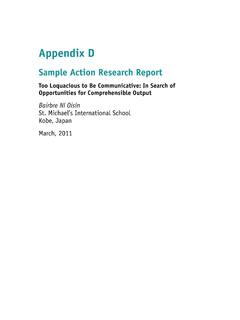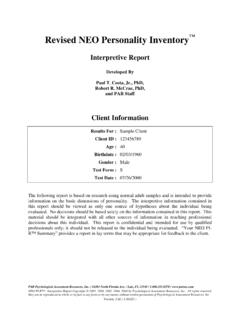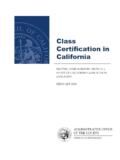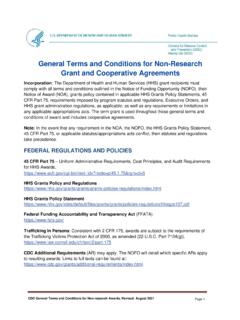Transcription of ACTION RESEARCH IN EDUCATION : EFFECTIVENESS OF …
1 FLIPPED CLASSROOM AND ACADEMIC PERFORMANCE 1. ACTION RESEARCH IN EDUCATION : EFFECTIVENESS OF FLIPPED. CLASSROOM ON ACADEMIC PERFORMANCE OF STUDENTS. Mrs Aparna Vinay Date : 27th August 2020. FLIPPED CLASSROOM AND ACADEMIC PERFORMANCE 2. ABSTRACT. This study is an ACTION RESEARCH in the field of EDUCATION . In this RESEARCH paper I have tried to gauge the EFFECTIVENESS of flipped classroom as a strategy to improve the academic performance of students. The present study involved a sample of 14 AS and A level (CAIE. curriculum) psychology students from an International School in Mumbai. Active learning strategy of flipped classroom was used to foster teaching and learning process among students. The data collection was done using self-report, observation and objective assessment. The results supported the EFFECTIVENESS of flipped classroom on academic performance. The strategy helped improve the grades of students who were at the lower end of academic performance.
2 KEY WORDS. Flipped Classroom, academic performance,CAIE Cirriculum FLIPPED CLASSROOM AND ACADEMIC PERFORMANCE 3. INTRODUCTION. The field of EDUCATION has transformed in the past couple of decades. There are many innovations that have crept in. From active learning strategies which focus on a participative approach in teaching, to virtual classrooms that have brought schools into our homes, we have it all. The focus has changed from content to concept. The demographics of EDUCATION have changed and so has its purpose. The academic performance still remains an important criterion of determining success in one's educational life. However, in the present time the importance of skill building and easing the transfer of learning to workplace has also found a place in discussion of academics. The schools today cater to a wide range of students ranging from academically bright to those with special educational needs. As a teacher our accountability has increased and we are expected to teach all the different types of students and help all of them excel.
3 On the face of it, it's a very tough task. As teachers we try our best to ensure that our students achieve marks according to their maximum potential. This involves helping them understand the material and apply the concepts aptly. After years of teaching it might be difficult for a teacher to understand exactly where to start from. The judgement about the level of understanding of students might be coloured by the level of understanding or performances of the previous batches. Hence having a student revise the concept instead of the teacher might come handy as a teaching strategy as the ground zero will be the same for both the teacher and the learner. I decided to conduct this study as I realized that sometimes the concepts and examples that I. thought as being easily understandable and simple were not absorbed by all the students equally well. In spite of having similar capability and absolutely no learning disability they FLIPPED CLASSROOM AND ACADEMIC PERFORMANCE 4.
4 Did not seem to connect with the concept or example. During one such instance in my classroom despite going over the concept and examples again and again the student did not understand. At this point another peer gave a very every teenager ever kind of example and this student could instantly see the connection. This made me think that probably the examples that I find relevant might not be as well understood by students as someone of their own age and those who share their lingos and lifestyle. Thus I thought of using the strategy of flipped classroom to help students perform better in academics as this strategy would not just help students connect with a teacher of similar mental age, but also expose students to a variety of teaching and learning aids and strategies. IDENTIFICATION OF THE PROBLEM. Students failed to score on specific concepts despite the teacher giving relevant examples or simplifying the concept. HYPOTHESIS.
5 Flipped Classroom will help promote understanding of concept that will increase the academic performance The RESEARCH questions that I am focusing on are: 1. Will Flipped Classroom aid understanding of the concept? 2. Will the students be able to improve their scores after having revision class using Flipped Classroom? FLIPPED CLASSROOM AND ACADEMIC PERFORMANCE 5. REVIEW OF LITERATURE. FLIPPED CLASSROOM. The origins of Peer teaching and learning can be traced back to the time of Aristotle where he used archons student leaders to help their peers understand what is taught. Scotsman Andrew Bell in 1795 was the first to come up with a theory of Peer learning. During the 19th Century this strategy had been used in English and French Schools. Over the past few years this method has been used in various schools to teach students with mixed ability. Jonathan Bergmann and Aaron Sams (2012) could be credited as pioneers of flipped classroom.
6 Flipped classroom is an active learning strategy where the student learns the concept at home and practices it in school. It involves role reversal of the traditional pedagogy of teaching. Here the students take active role in the classroom rather than being a passive spectator. Flipped classroom involves the amalgamation of traditional face to face learning and modern technology such as videos, online simulations and pre-recorded lectures. According to Prensky (2001) an average college graduate spends 10,000 hours playing video games and around 20,000 hours watching television. Emails, computer games, cell phone, internet and instant messaging have become an important part of their life and hence they will be more open to studying using these means. Flipped Classroom is in line with the constructivist approach to teaching where new ideas are built on previous learning experience (Schunk,2011). It also supports another principle of constructivism where the learner is responsible for their own learning.
7 FLIPPED CLASSROOM AND ACADEMIC PERFORMANCE 6. Flipped classroom has numerous advantages: (a)It helps a student come prepared for the lecture at least with some background knowledge,(b) it helps increase collaboration among student, (c)it helps a teacher gain better understanding about the potential of a student,(d) it also helps increase student engagement and student involvement,(e) it helps students with special educational needs to learn at their own pace through a medium that they understand. Bergmann and Sams (2012) mention in their book that use of flipped classroom reduced the time taken by the students to learn and was found to be very useful for those students who missed their lectures due to sports practice. In a study conducted by Graham (2013), three high school math classrooms that had flipped the instructional procedure were surveyed to examine students perceptions of the flipped Classroom. It aimed to assess the role of social media, educational technology, mastery learning and self-pacing in flipped classroom environments.
8 The results revealed three major findings: students were having less homework in a flipped classroom than in a traditional lecture-based classroom, students enjoyed learning in a flipped classroom environment, and students benefited from watching their lectures in condensed lesson videos. Thus, highlighting the EFFECTIVENESS of this method. Another study was conducted by Kenna (2014) to identify the effect of the flipped classroom on student self-efficacy and the difference in self-efficacy between genders using this model. It had 22 Physics students in two classes, a traditional and a flipped classroom. Self-Efficacy Survey was used to score the self-efficacy of students. The results showed an increase in their average self-efficacy score with the flipped classroom while the traditional classroom decreased their average score. FLIPPED CLASSROOM AND ACADEMIC PERFORMANCE 7. In a study conducted by Chen, Lui, and Martinelli (2017), they conducted a systematic review of 46 articles on the EFFECTIVENESS of flipped classrooms in medical EDUCATION with different learning outcomes such as EFFECTIVENESS , perception of students towards flipped classroom, attitude and changes in knowledge, skill and behaviour.
9 The results indicated that the EFFECTIVENESS was inconsistent as some studies suggested benefits while some suggested marginal improvement over traditional teaching method. However, the perception and attitude of the students towards flipped classroom was positive as they reported less boredom, more enjoyment and greater task value. The results for changed knowledge, skill and behaviour compared to the traditional methods were again mixed. This implies the need for further RESEARCH in this area. FLIPPED CLASSROOM AND ACADEMIC PERFORMANCE 8. METHOD. SAMPLE. This study consisted of 14 AS and A levels Psychology students. The age range was 15-18. year-olds. There were 2 boys and 12 girls in this study. 6 students from A levels and 8 from AS level participated in this study. 3 of the students in this sample were diagnosed with learning disability. Opportunity sampling was used. PROCEDURE. The study was conducted in an International School.
10 The students were not aware of being a part of the RESEARCH of this RESEARCH study so consent was not taken initially. However, they were informed about it at the end of the year and consent was obtained to publish their data. Consent was not taken initially because along with the objective assessments this study also involves self-report in the form of a questionnaire. I did not want the responses of the students to be coloured with any factor other than what they genuinely felt about this strategy. I taught the students all the chapters. The strategy of flipped Classroom was used during revision. This was done because students take psychology directly at AS level without any background knowledge. So, expecting them to teach a discipline without knowing about it would have marred the purpose of this study. Also, the A level curriculum is tough for students to understand by themselves. After teaching all the concepts or topics, these students were asked to choose the topics they wanted to present and the topics were locked.


















